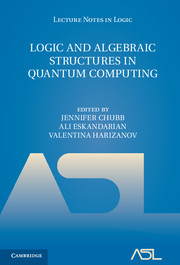Book contents
- Frontmatter
- Contents
- Preface
- Introduction
- 1 A (very) brief tour of quantum mechanics, computation, and category theory
- 2 Could logic be empirical? The Putnam-Kripke debate
- 3 The essence of quantum theory for computers
- 4 Fiber products of measures and quantum foundations
- 5 Operational theories and categorical quantum mechanics
- 6 Relating operator spaces via adjunctions
- 7 Topos-based logic for quantum systems and bi-Heyting algebras
- 8 The logic of quantum mechanics – Take II
- 9 Reasoning about meaning in natural language with compact closed categories and Frobenius algebras
- 10 Knot logic and topological quantum computing with Majorana fermions
- Index
- References
8 - The logic of quantum mechanics – Take II
Published online by Cambridge University Press: 05 June 2016
- Frontmatter
- Contents
- Preface
- Introduction
- 1 A (very) brief tour of quantum mechanics, computation, and category theory
- 2 Could logic be empirical? The Putnam-Kripke debate
- 3 The essence of quantum theory for computers
- 4 Fiber products of measures and quantum foundations
- 5 Operational theories and categorical quantum mechanics
- 6 Relating operator spaces via adjunctions
- 7 Topos-based logic for quantum systems and bi-Heyting algebras
- 8 The logic of quantum mechanics – Take II
- 9 Reasoning about meaning in natural language with compact closed categories and Frobenius algebras
- 10 Knot logic and topological quantum computing with Majorana fermions
- Index
- References
Summary
Abstract. We put forward a new take on the logic of quantum mechanics, following Schrödinger's point of view that it is composition which makes quantum theory what it is, rather than its particular propositional structure due to the existence of superpositions, as proposed by Birkhoff and von Neumann. This gives rise to an intrinsically quantitative kind of logic, which truly deserves the name ‘logic’ in that it also models meaning in natural language, the latter being the origin of logic, that it supports automation, the most prominent practical use of logic, and that it supports probabilistic inference.
The physics and the logic of quantum-ish logic. In 1932 John von Neumann formalized Quantum Mechanics in his book “Mathematische Grundlagen der Quantenmechanik”. This was effectively the official birth of the quantum mechanical formalism which until now, some 75 years later, has remained the same. Quantum theory underpins so many things in our daily lives including chemical industry, energy production and information technology, which arguably makes it the most technologically successful theory of physics ever.
However, in 1935, merely three years after the birth of his brainchild, von Neumann wrote in a letter to American mathematician Garrett Birkhoff: “I would like to make a confession which may seem immoral: I do not believe absolutely in Hilbert space no more.” (sic)—for more details see [73].
Soon thereafter they published a paper entitled “The Logic of Quantum Mechanics” [13]. Their ‘quantum logic’ was cast in order-theoretic terms, very much in the spirit of the then reigning algebraic view of logic, with the distributive law being replaced with a weaker (ortho)modular law.
This resulted in a research community of quantum logicians [68, 71, 47, 30]. However, despite von Neumann's reputation, and the large body of research that has been produced in the area, one does not find a trace of this activity neither in the mainstream physics, mathematics, nor logic literature. Hence, 75 years later one may want to conclude that this activity was a failure.
What went wrong?
The mathematics of it. Let us consider the raison d'être for the Hilbert space formalism.
- Type
- Chapter
- Information
- Logic and Algebraic Structures in Quantum Computing , pp. 174 - 198Publisher: Cambridge University PressPrint publication year: 2016

